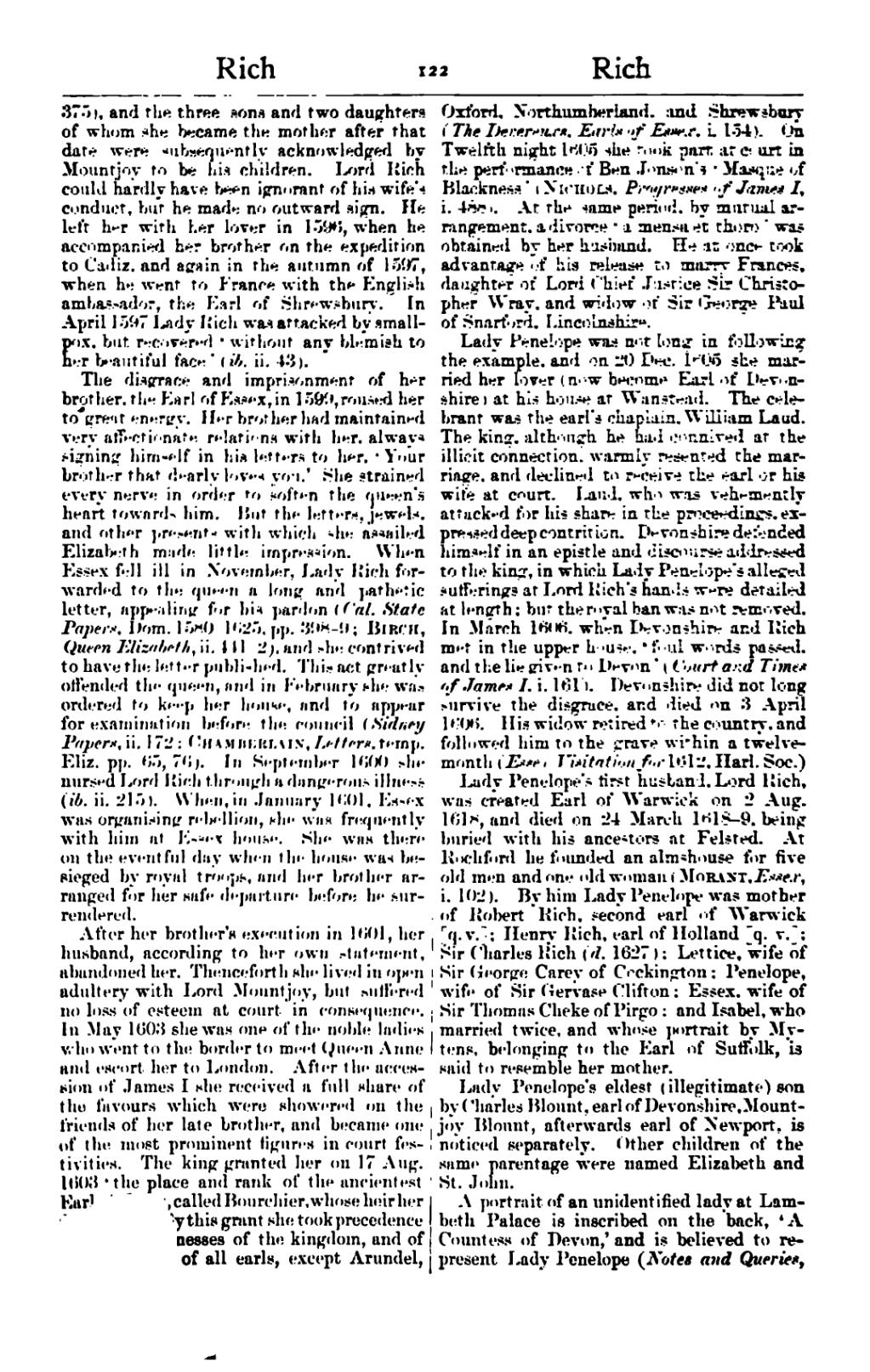375), and the three sons and two daughters of whom she became the mother after that date were subsequently acknowledged by Mountjoy to be his children. Lord Rich could hardly have been ignorant of his wife's conduct, but he made no outward sign. He left her with her lover in 1596, when he accompanied her brother on the expedition to Cadiz, and again in the autumn of 1597, when he went to France with the English ambassador, the Earl of Shrewsbury. In April 1597 Lady Rich was attacked by smallpox, but recovered ‘without any blemish to her beautiful face’ (ib. ii. 43).
The disgrace and imprisonment of her brother, the Earl of Essex, in 1599, roused her to great energy. Her brother had maintained very affectionate relations with her, always signing himself in his letters to her, ‘Your brother that dearly loves you.’ She strained every nerve in order to soften the queen's heart towards him. But the letters, jewels, and other presents with which she assailed Elizabeth made little impression. When Essex fell ill in November, Lady Rich forwarded to the queen a long and pathetic letter, appealing for his pardon (Cal. State Papers, Dom. 1580–1625, pp. 398–9; Birch, Queen Elizabeth, ii. 441–2), and she contrived to have the letter published. This act greatly offended the queen, and in February she was ordered to keep her house, and to appear for examination before the council (Sidney Papers, ii. 172; Chamberlain, Letters, temp. Eliz. pp. 65, 76). In September 1600 she nursed Lord Rich through a dangerous illness (ib. ii. 215). When, in January 1601, Essex was organising rebellion, she was frequently with him at Essex house. She was there on the eventful day when the house was besieged by royal troops, and her brother arranged for her safe departure before he surrendered.
After her brother's execution in 1601, her husband, according to her own statement, abandoned her. Thenceforth she lived in open adultery with Lord Mountjoy, but suffered no loss of esteem at court in consequence. In May 1603 she was one of the noble ladies who went to the border to meet Queen Anne and escort her to London. After the accession of James I she received a full share of the favours which were showered on the friends of her late brother, and became one of the most prominent figures in court festivities. The king granted her on 17 Aug. 1603 ‘the place and rank of the ancientest Earl of Essex, called Bourchier, whose heir her father was.’ By this grant she took precedence of all the baronesses of the kingdom, and of the daughters of all earls, except Arundel, Oxford, Northumberland, and Shrewsbury (The Devereuxs, Earls of Essex, i. 154). On Twelfth night 1605 she took part at court in the performance of Ben Jonson's ‘Masque of Blackness’ (Nichols, Progresses of James I, i. 488). At the same period, by mutual arrangement, a divorce ‘a mensa et thoro’ was obtained by her husband. He at once took advantage of his release to marry Frances, daughter of Lord Chief Justice Sir Christopher Wray, and widow of Sir George Paul of Snarford, Lincolnshire.
Lady Penelope was not long in following the example, and on 20 Dec. 1605 she married her lover (now become Earl of Devonshire) at his house at Wanstead. The celebrant was the earl's chaplain, William Laud. The king, although he had connived at the illicit connection, warmly resented the marriage, and declined to receive the earl or his wife at court. Laud, who was vehemently attacked for his share in the proceedings, expressed deep contrition. Devonshire defended himself in an epistle and discourse addressed to the king, in which Lady Penelope's alleged sufferings at Lord Rich's hands were detailed at length; but the royal ban was not removed. In March 1606, when Devonshire and Rich met in the upper house, ‘foul words passed, and the lie given to Devon’ (Court and Times of James I, i. 161). Devonshire did not long survive the disgrace, and died on 3 April 1606. His widow retired to the country, and followed him to the grave within a twelvemonth (Essex Visitation for 1612, Harl. Soc.).
Lady Penelope's first husband, Lord Rich, was created Earl of Warwick on 2 Aug. 1618, and died on 24 March 1618–9, being buried with his ancestors at Felsted. At Rochford he founded an almshouse for five old men and one old woman (Morant, Essex, i. 102). By him Lady Penelope was mother of Robert Rich, second earl of Warwick [q. v.]; Henry Rich, earl of Holland [q. v.]; Sir Charles Rich (d. 1627); Lettice, wife of Sir George Cary of Cockington; Penelope, wife of Sir Gervase Clifton; Essex, wife of Sir Thomas Cheke of Pirgo; and Isabel, who married twice, and whose portrait by Mytens, belonging to the Earl of Suffolk, is said to resemble her mother.
Lady Penelope's eldest (illegitimate) son by Charles Blount, earl of Devonshire, Mountjoy Blount, afterwards earl of Newport [q. v.], is noticed separately. Other children of the same parentage were named Elizabeth and St. John.
A portrait of an unidentified lady at Lambeth Palace is inscribed on the back, ‘A Countess of Devon,’ and is believed to represent Lady Penelope (Notes and Queries,
